Libya Travel Guide
This is a Libya Travel Guide from taste2travel.com
Date Visited: July 2023
Introduction
I have wanted to visit Libya for many years – decades actually!
However, any effort to gain a visa in the past was thwarted by either the reclusive Ghaddafi regime, who were not welcoming of tourists, or ongoing civil wars and other unrest.
In recent times, it seems that something resembling peace has returned to Libya and that the country is now creaking open the door to tourism.

The fortified granary in the town of Kabaw is one of many fascinating sights to be explored in Libya.
Currently, all tourists need to apply for a visa through a Libyan-registered tour company and tourists must be fully escorted by the tour company during their stay in Libya.
I toured Libya with Tidwa Tours who I would highly recommend. Tidwa offer bespoke itineraries for independent travellers, starting from just two days. I have included full details for Tidwa Tours in the Tour Companies section below.
I was told that currently, there are four companies offering tours to Libya and that maybe 30 tourists per month visit Libya.
An additional requirement, at the moment, is that all tourists must be escorted by a police escort.
My escort was friendly, wore plain clothes and carried no weapon. He played ride-along and ensured our path was smooth and clear which is helpful in a country with many police checkpoints.

A highlight of Libya, the ancient Roman city of Leptis Magna is considered to be the best-preserved Roman ruin in all of the Mediterranean.
All the Libyans I met, including the police, were very friendly, welcoming and respectful. In one town, we even had a police escort through town (including flashing lights) just as a courtesy.
The most surprising and unexpected things can happen during a trip to Libya!
As for security, at no stage did I feel threatened or in danger. I was always treated with kindness and respect. The Libyans were truly happy to meet a tourist in their country and they are keen to show their ancient treasures to those willing to visit.

Exploring the ancient, abandoned, village of Tormisa, which is perched on the edge of a dramatic escarpment in the Nafusa Mountains, west of Tripoli.
Strategically located on the Mediterranean Sea, sandwiched between the vast African continent to the south and Europe to the north, Libya has been an important centre of trade and commence for many millennia.
Due to its location, every major empire has occupied Libya at some stage, from the Romans, the Greeks, the Ottomans, up to modern day occupiers such as the Italians.

The Meditereanean Sea forms a nice backdrop to two marble columns on the top tier of the Roman theatre at Leptis Magna.
All of these occupiers have left their mark, none more so than the Romans who built the impressive cities of Leptis Magna and Sabratha. The ruins of both of these sprawling ancient cities are now listed as UNESCO World Heritage sites.
Leptis Magna is considered to be the best-preserved Roman city anywhere in the Mediterranean, while the Roman theatre at Sabratha (cover photo) is considered to be the most fully intact Roman theatre anywhere in the world.
Libya offers a multitude of incredible sights, both along the Mediterranean Sea, and further inland in the Sahara Desert, where Berber tribes have existed for thousands of years.

Marble columns, installed on the top tier of the Roman theatre at Leptis magna.
After decades of Ghaddafi, and then more than 10 years of the Libyan Civil War, the country is very much broken and on its knees. It’s currently dusting itself off and attempting to get back up on its feet!
The process of rebuilding Libya, from the broken infrastructure, government, institutions, and a society which has suffered so much loss, will take decades.

An abandoned tank on the side of the road, a regular sight in Libya, a country with a turbulent history.
While Libya has experienced its share of political challenges, it boasts a wealth of attractions for those seeking a unique and off-the-beaten-path travel experience.
For those intrepid travellers who don’t mind being in a gritty, edgy environment, now is a perfect time to visit. You will have the country, and all those world-class sights, to yourself!
I enjoyed my time in Libya and look forward to visiting again!
Location
Tripoli, Libya
Libya is located in North Africa, bordered by the Mediterranean Sea to the north, Tunisia to the west, Algeria to the southwest, Egypt to the east, Sudan to the southeast and Chad and Niger to the south.

Due to its strategic location on the Mediterranean Sea, Libya has been an important centre of trade and commence for millennia and has been occupied by most of the major empires, including the Romans.
The Mediterranean coastline stretches for approximately 1,770 km (1,099.8 mi) which has, historically, made Libya an important country for trade and transportation. The coastline features the ruins of several ancient Roman cities.

A view of the vast desert plain in western Libya, from the escarpment which defines the dramatic northern edge of the Nafusa mountains.
Much of Libya’s interior is dominated by the Sahara Desert, the largest hot desert in the world. The Sahara covers a significant portion of the country, featuring vast sand dunes, rocky plateaus, and arid expanses.
People
Home to 6.7 million souls, Libya has been inhabited since at least 8000 BCE.
I found the Libyans to be friendly, respectful and welcoming! They were very happy to meet a tourist in their country and they related to me that they hope tourism can finally develop now that the situation in the country has become more stable and (relatively) safe.
While the population is primarily Arab, there are sizeable Berber and Tuareg communities, who primarily inhabit the interior desert regions.
The Arab majority rule the roost in Libya, with the official language being Arabic and the politics being dominated by Arabs. Islamic traditions, customs, and values also hold sway in the daily lives of most Libyans.
While Arabs make up the largest ethnic group, there are also notable Berber and Tuareg communities in Libya. These indigenous groups have their own languages, cultures, and traditions.
In some regions, particularly in the western mountains, you can find Berber-speaking communities that have retained their distinct cultural practices.
Islam is the predominant religion in Libya, with the majority of Libyans adhering to the Sunni branch of Islam.
Islamic values influence various aspects of daily life, including family structure, social norms, and legal matters.
Flag
Present Flag

The present flag of Libya.
The national flag of Libya was originally introduced in 1951, following the creation of the Kingdom of Libya.
The flag consists of a triband red–black–green design, the central black band being twice the width of the outer bands. A white star and crescent are located in the centre of the flag.
The crescent is symbolic of the beginning of the lunar month according to the Muslim calendar, while the star represents hope.
The horizontal stripes represent:
- Red Stripe: symbolises the sacrifices made by Libyan martyrs during various struggles for independence and freedom.
- Black Stripe: represents the dark period of oppression and colonisation that Libya and its people endured.
- Green Stripe: signifies the hope and promise of a brighter future for Libya as a free and sovereign nation. Green is also associated with Islam and is often considered a color of prosperity.
Former Flag

The plain green Libyan flag which was used during the rule of Muammar Gaddafi.
In 1977, during the rule of Muammar Gaddafi, the Libyan flag was changed to plain green – which represented the colour if Islam.
At the time, it was the only national flag which consisted of one single colour.
However, after Gaddafi’s assassination in 2011, the original flag design with the red, black, and green stripes was reinstated as the national flag.
Currency

The Libyan Dinar is the official currency of Libya.
The official currency of Libya is the Libyan dinar, which is often abbreviated as “LYD” which is also its international currency code.
The Libyan Dinar is further subdivided into smaller units called dirhams. The currency is issued and regulated by the Central Bank of Libya.
The Libyan dinar is not freely tradable outside of the country so it’s essential that you spend all of your dinar before leaving the country.

Uncirculated, five Libyan dinar, polymer banknotes.
While all banknotes are printed on paper, a new 5-dinar polymer (plastic) banknote is now in circulation and makes for a great souvenir!
Exchange Rates
The exchange rate at August 2023 for US dollars is:
US$100 = LYD 480
To check the current exchange, please click here.
There is a very lively currency exchange market in Tripoli old town, where traders carry their Libyan dinar around in wheelbarrows. Truly impressive!
Black Market
While a currency black market does exist, the unofficial rate is not much higher than the official rate.
During my stay, the official exchange rate was US$1 = LYD 4.8, while the unofficial rate was US$1 = LYD 5.5!
ATMs
ATMs do not exist in Libya!
Credit Cards
Credit cards cannot be used in Libya!
Libya is a cash society!
Costs
Travel costs to Libya are not cheap since visitors need to pay for a fully inclusive, fully guided tour.
An added expense comes from the current government requirement for a tourist police escort. A police officer is required to accompany all tourists, including a single traveller such as myself, from arrival until departure!
My police escort was friendly, wore plain clothes, and was unarmed!
Additionally, flight costs to Libya are not cheap.
You can expect to pay around US$2,000 for a tour of just a few days, which also includes the airfare and all tour costs.
Tour Companies

Currently, the only way to visit Libya is through a Libyan-registered tour company, who will arrange a tourist visa as part of a package tour.
You will be fully escorted from the moment you arrive until the moment you depart. You will also be accompanied by a police officer!

Sharing a typical Libyan meal with my guide Masoud (right) and my police escort Muhammad, who is, fittingly, slightly in the shadows.
A tour of Libya isn’t cheap but it’s all inclusive. As part of a tour, you will be collected from the airport, taken to your accommodation, which will be arranged by the tour company, then fully escorted during your time in the country.
It seems all visitors to Libya are accommodated at the Four Points by Sheraton Hotel which is located on the seafront in downtown Tripoli.

Touring the Libyan countryside, with Tidwa Tours, in a very comfortable Kia, which I had to myself.
Despite being the best hotel in the country, the Sheraton had no power from the city grid during my entire stay. The hotel was powered by one generator the whole time. Please refer to the Accommodation section for more information on this hotel.
I toured Libya with Tidwa Tours who I would highly recommend. Tidwa offer bespoke itineraries for independent travellers, starting from just two days.
For more information you should contact Masoud at Tidwa Tours:
- Website: https://tidwa.com/
- Instagram: https://www.instagram.com/tidwatours/
- Facebook: https://www.facebook.com/Tidwa.Tours/
- WhatsApp: +218 91 15 21 561
Sightseeing
Tripoli
Known in ancient times as Oea, modern day Tripoli was founded in the 7th century BCE by the Phoenicians who were probably attracted to the site by its natural harbour.
The city then passed to the Greeks who named it Oea. By the latter half of the 2nd century CE, Oea was conquered by the Romans, who included it in their province of Africa, and gave it the name of Regio Syrtica.
Around the beginning of the 3rd century CE, it became known as Regio Tripolitana, meaning “region of the three cities” – i.e., Oea (modern Tripoli), Sabratha and Leptis Magna.
Security in Tripoli Old Town
As I entered Martyrs’ Square, accompanied by my guide and police escort, I could sense that we were being shadowed by a young man who was busy talking on a walkie-talkie.
My guide explained that there is a dedicated tourist police unit who are responsible for escorting tourists around the square and the old town and that he would accompany us during our walk. He actually accompanied us all the way back to our car!
As I walked around the old town, guided by my guide Masoud, we were followed by two police officers. We were quite the posse!
Arch of Marcus Aurelius

Erected in 165 CE, entirely from marble, the Arch of Marcus Aurelius is a Roman triumphal arch, which is, today, a highlight of the old town.
The one remaining vestige of the Roman era in Tripoli is the Arch of Marcus Aurelius which was erected in 165 CE.
Built entirely from marble, the arch, which has been partially buried over the course of the centuries, was damaged during WWII and today is suffering from the effects of acid rain and damage from tourists.
Martyrs’ Square

Libyan flags, flying over Martyrs’ Square in Tripoli, with the walls of the medina and the Red Castle visible in the background.
Originally constructed by the Italians during their occupation of Libya, Martyrs’ Square is a downtown landmark in the heart of Tripoli old town.
Tripoli Old Town

A view of the Ottoman-era prison which lies in the heart of Tripoli old town.
Leading off of Martyrs’ Square, the walled old town (medina) is distinguished by a warren of narrow laneways which are lined with all sorts of shops selling everything from gold jewellery to appliances, clothing, shoes and household goods.

The Catholic church of Santa Maria degli Angeli, overlooks a small square in Tripoli old town.
Also tucked away inside the old town is an Ottoman-era prison and clocktower, an old Turkish hammam (bathhouse) and a Catholic church.

This Ottoman-era clock tower is an icon of Tripoli old town.
During its history, Tripoli has been occupied by most major empires, including the Ottomans who ruled from 1551 to 1911.
Several notable examples of Ottoman-era architecture can be seen in the old town, including an impressive 5-story, 30-metre-high, clocktower, which was built between 1901 and 1902.

A view of the walled medina – Tripoli old town.
What is known as the Wall Street of Tripoli is a section of the medina comprised of many money traders who gather on the street, in the shadow of the clock tower.
This open, informal money market can be very busy with people buying and selling currencies. The traders tend to cart their Libyan dinar in black garbage bags, inside wheelbarrows.

Inside Tripoli old town, the Dargouth Turkish hammam is still operating -for those seeking an invigorating scrub and massage.
For those seeking an invigorating scrub and massage, the Dargouth Turkish bath is an antique Ottoman-era hamman.

A view of the walls of Tripoli old town and the imposing Red Castle.
The Red Castle is a major landmark on the waterfront, bordering Martyrs’ Square. It has been the home of the Red Castle Museum since 1919, and of the Libyan Department of Archaeology since 1952.
Leptis Magna

Completed in 1 CE, the Roman theatre at Leptis Magna is the oldest in Roman Africa.
Introduction
Located 130 km east of the Libyan capital city of Tripoli, Leptis Magna, was once a prominent city of the Carthaginian Empire and an important city of the Roman Empire.

One of many spectacular views at Leptis Magna.
One of several UNESCO World Heritage Sites in Libya, Leptis Magna is an immensely important and significant site to visit.

A view of the Baths of Hadrian at Leptis Magna.
It is considered to be the most important Roman site in the world, as it is widely recognised as the best-preserved Roman city outside of Italy, and, unlike most ancient ruins, its well-preserved remains give a clear picture as to what a complete Roman city would have looked like.
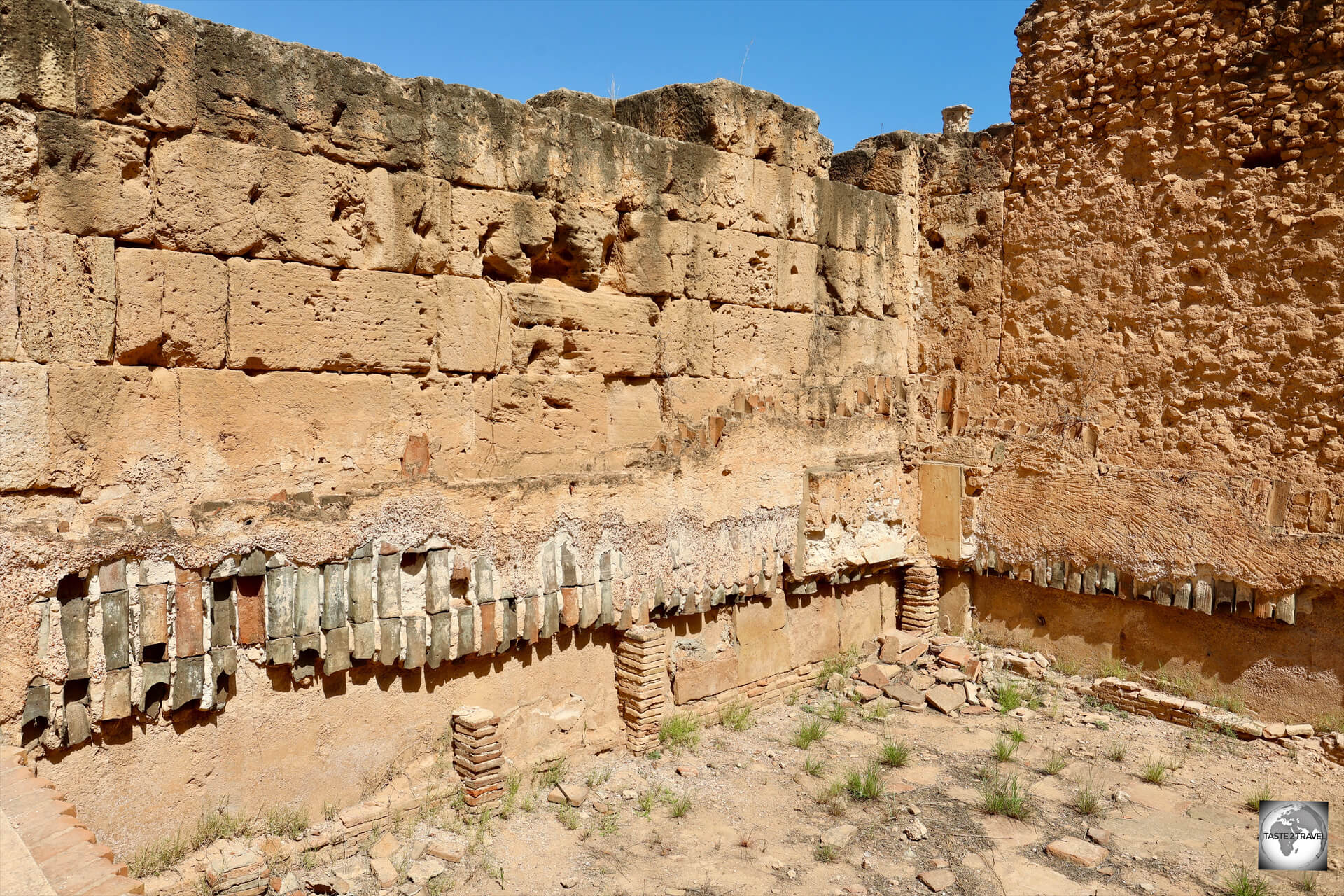
A view of the steam room at the Baths of Hadrian at Leptis Magna, which shows terracotta pipes still attached to the walls.
Leptis Magna was founded by a group of local Berbers and Phoenicians sometime around 1000 BC. In 42 BC, the city became under the rule of the Roman Empire.
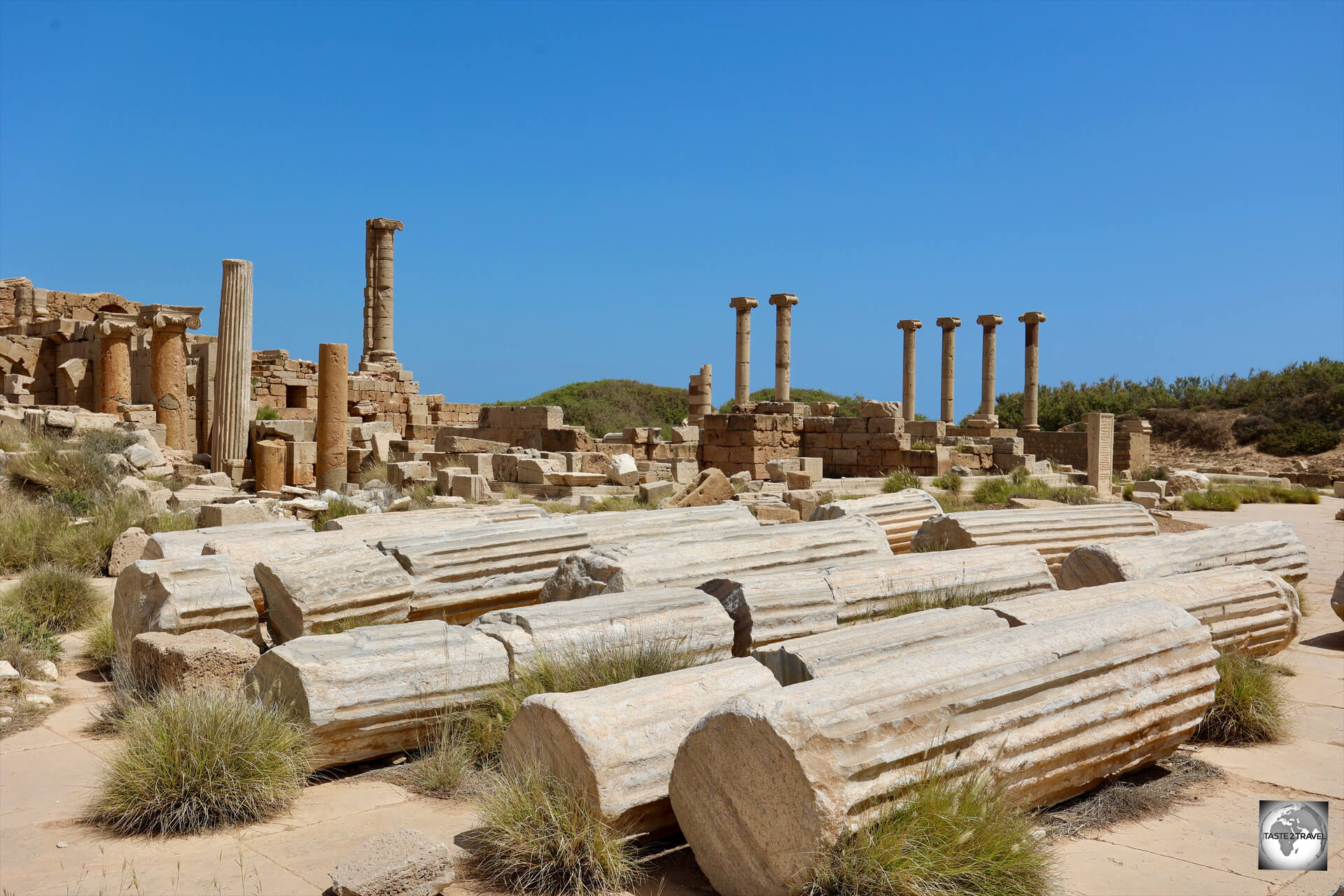
No shortage of marble columns at Leptis Magna.
This once grand city stretches for many kilometres along the Mediterranean coast.

The ruins of Leptis Magna overlook the Mediterranean Sea.
We travelled between some of the sites by car which was appreciated in the searing 45-degree Celsius heat.

Located more than one kilometre from the main site, the Amphitheatre at Leptis Magna could accommodate 16,000 spectators.
There is so much to see at Leptis Magna and I could have easily spent two days slowly exploring the site, but the baking heat, and complete lack of shade, became too much after just a few hours. Best to plan your visit during winter!

A view of the Roman theatre at Leptis Magna.
History
This vast ancient Roman metropolis actually started life as a 7th-century (BCE) Phoenician village.

Marble columns, carved friezes, column capitals and much more, inside the Severan Forum at Leptis Magna.
Under Roman emperor Tiberius, Leptis Magna and the surrounding area were formally incorporated into the Roman empire in 46 BCE as part of the province of Africa.

A view, through a gateway at the Severan Forum, onto one of the many residential streets at Leptis Magna.
It soon became one of the leading cities of Roman Africa and a major trading post. The 3rd Augustan Legion was stationed here to defend the city against Berber incursions.

No shortage of marble building blocks inside the very large Severan Forum at Leptis Magna.
After the legion’s dissolution under Gordian III in 238 CE, the city was increasingly open to raids in the later part of the 3rd century.

The marble latrines at Leptis Magna with the Baths of Hadrian in the background.
Diocletian reinstated the city as provincial capital, and it grew again in prosperity until it fell to the Vandals in 439 CE.

A view, through a gateway at the Severan Forum, onto one of the many residential streets at Leptis Magna.
It was reincorporated into the Eastern Empire in 533 CE but continued to be plagued by Berber raids and never recovered its former importance.

A view of the Nymphaeum, which marked the end of an impressive colonnaded street, which ran 400 metres from the harbour.
Leptis Magna eventually fell to the Muslim invasion in 647 CE and was subsequently abandoned.

A view of the Nymphaeum at Leptis Magna which once featured an ornamental fountain.
This pearl of the Roman empire was one of the most beautiful cities in the entire empire, complete with imposing public monuments, a harbour, a theatre, an amphitheatre, market-place, storehouses, shops, a bathhouse, residential districts and much more.

Leptis Magna is full of ingenious architectural designs, such as this angled doorway at Hadrian’s bathhouse which would have reduced wind flow.
Excavations
For many centuries, Leptis Magna lay abandoned, forgotten and long covered by desert sand, soil, dust and mud.

Arches, with Medusa heads, line one side of the Severan Forum at Leptis Magna.
Previous excavations, notably by Italian archaeologists after WWI, have uncovered just a small fraction of the site.

An inscription, outside the Baths of Hadrian, commemorates the opening of the bathhouse.
Under the Ghaddafi regime, there was little interest in cultural sites, so Leptis Magna remained untouched for many decades.
Then the Libyan Civil War came, and now something resembling peace has prevailed.

A view of the Mediterranean Sea from the Roman theatre at Leptis Magna.
However, the task of excavating such a huge site is daunting and currently there are no plans to commence excavations.

Marble-clad shopfronts line one section of the Severan Forum at Leptis Magna.
Leptis Magna is regarded as one of the next preserved Roman sites anywhere in the Mediterranean region, which is thanks in large part to the fact that it has remained buried and undisturbed for so long!

Entrance to the Severan Forum, one of the main squares at Leptis Magna.
Site Expert/ Guide

My informative guide, Mahmoud, at Leptis Magna.
I did a walking tour of Leptis Magna with a local guide and expert – Mahmoud. On the day of my visit, the mercury topped out at 45-degrees Celsius. It was a hot walk!

Mahmoud pointed out the uniqueness of these 4-sided Doric columns – something I’d never seen before.
Mahmoud has published two guides on Leptis Magna and is a real expert. He was able to describe in detail how the city functioned under the Romans. He was able to effectively bring history to life.
I highly recommend Mahmoud as an authoritative guide to Leptis Magna.
Arch of Septimius Severus
Leptis Magna was enlarged and embellished by Septimius Severus, who was born there and later became emperor of the Roman empire.

The Arch of Septimius Severus is a triumphal arch in Leptis Magna. It was commissioned by the Libya-born Roman Emperor Septimius Severus.
At the entrance to this vast site, visitors are greeted by the very impressive Arch of Septimius Severus, a triumphal arch which was commissioned by Septimius Severus.
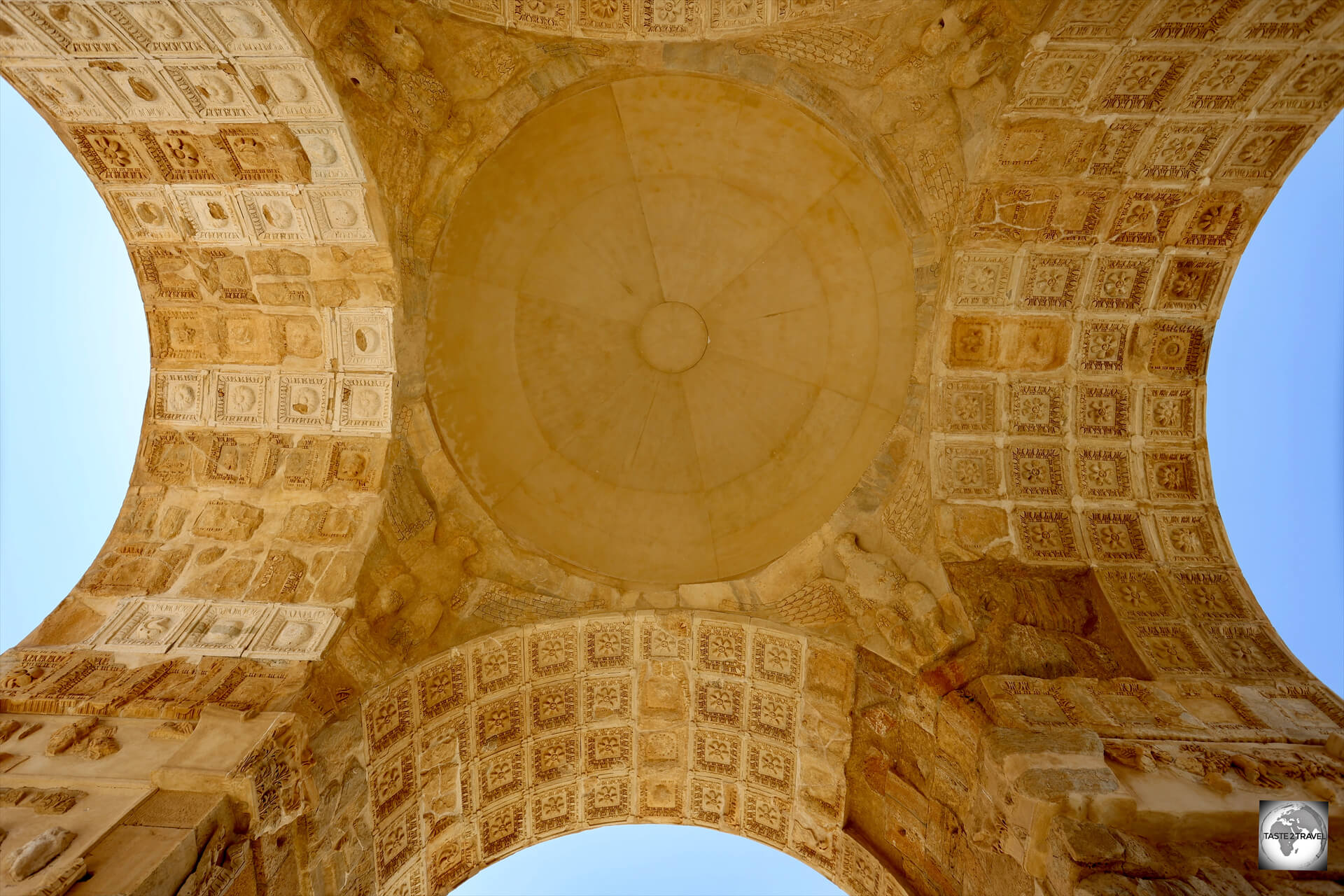
A view of the Arch of Septimius Severus at Leptis Magna.
When first discovered in 1928, the arch was in ruins, but was pieced back together by Italian archeologists.

Detail of the Arch of Septimius Severus in Leptis Magna.
While the exact date of construction is not agreed upon, it is generally accepted that the Arch of Septimius Severus was erected on the occasion of Severus’ African tour in 203 CE.

The Arch of Septimius Severus in Leptis Magna.
Severan Basilica

One of the first basilica’s ever built, the Severan Basilica includes a cross-shaped water trough.
Located adjacent to the Severan Forum, the Severan Basilica is one of many highlights of Leptis Magna.
After the Arch of Severus was offered to the emperor, Septimius Severus, on the occasion of his visit in 203 CE, the emperor responded by offering the basilica.

The intricately carved Column of Dionysus stands at the entrance to the Severan Basilica.
The entrance to the basilica is marked by pairs of very ornately carved Columns of Dionysus.
Market Place
Separate from both of the city’s forums, the Roman food market of Leptis Magna was built in 8 BCE.

One of the circular stalls, which lie at the heart of the market place at Leptis Magna.
Leptis Magna’s market is a particularly well-preserved feature of the Roman city. Along with typical porticoes of shops, the structure had two central circular stalls.

A view into the market courtyard at Leptis Magna.
The market was contained in a walled rectangular courtyard raised above the street level, reached by steps from the street, with the entrance barred at night.

Ingenious, double columns allowed for an octagonal-shaped portico to be constructed in the marketplace at Leptis Magna.
There are many notable features in the market, including stone blocks which had carved niches for holding weights and measures.
I especially liked the ingenious double columns which allowed the Romans to construct an octagonal portico.

This stone block in the market place at Leptis Magna was used by shop keeper’s for sharpening their knives.
Sabratha

A view of the ancient Roman city of Sabratha, a UNESCO World Heritage Site.
The ancient Roman city of Sabratha, now located in the Zawiya District of Libya, 70 km west of Tripoli, was the westernmost of the ancient “three cities” of Roman Tripolis, alongside Oea (Tripoli) and Leptis Magna.
An impressive, sprawling Roman city, if Sabratha was in any other country, it would be the #1 tourist attraction. However, in Libya, Sabratha plays second fiddle to the incredibly impressive Leptis Magna.

Roman columns of the Antonine temple at Sabratha, Libya.
A UNESCO World Heritage Site, Sabratha was founded by the Carthaginians as a trading post, it was first permanently settled in the 4th century BCE.

A distant view of the columns of the Antonine temple at Sabratha, Libya.
Sabratha had a modest natural harbour, later improved by the Romans, and together with Oea (Tripoli) it served as an outlet for the trans-Saharan caravan route through Ghadames.

Seen here at Sabratha, the Decumanus Maximus was an ancient Roman highway which ran along the north coast of Africa, connecting all the ancient Roman cities.
After a period of semi-independence following the fall of Carthage in 146 BC, it passed under Roman rule and thereafter enjoyed considerable prosperity.

The marble latrines at Sabratha are very comfortable.
The city was annexed to the Roman Republic as the province of Africa Nova in the 1st century BC.

A view of the Roman ruins at Sabratha.
It was subsequently romanised and rebuilt in the 2nd and 3rd centuries CE.
The Emperor Septimius Severus was born nearby in Leptis Magna, and Sabratha reached its monumental peak during the rule of the Severans, when it nearly doubled in size.
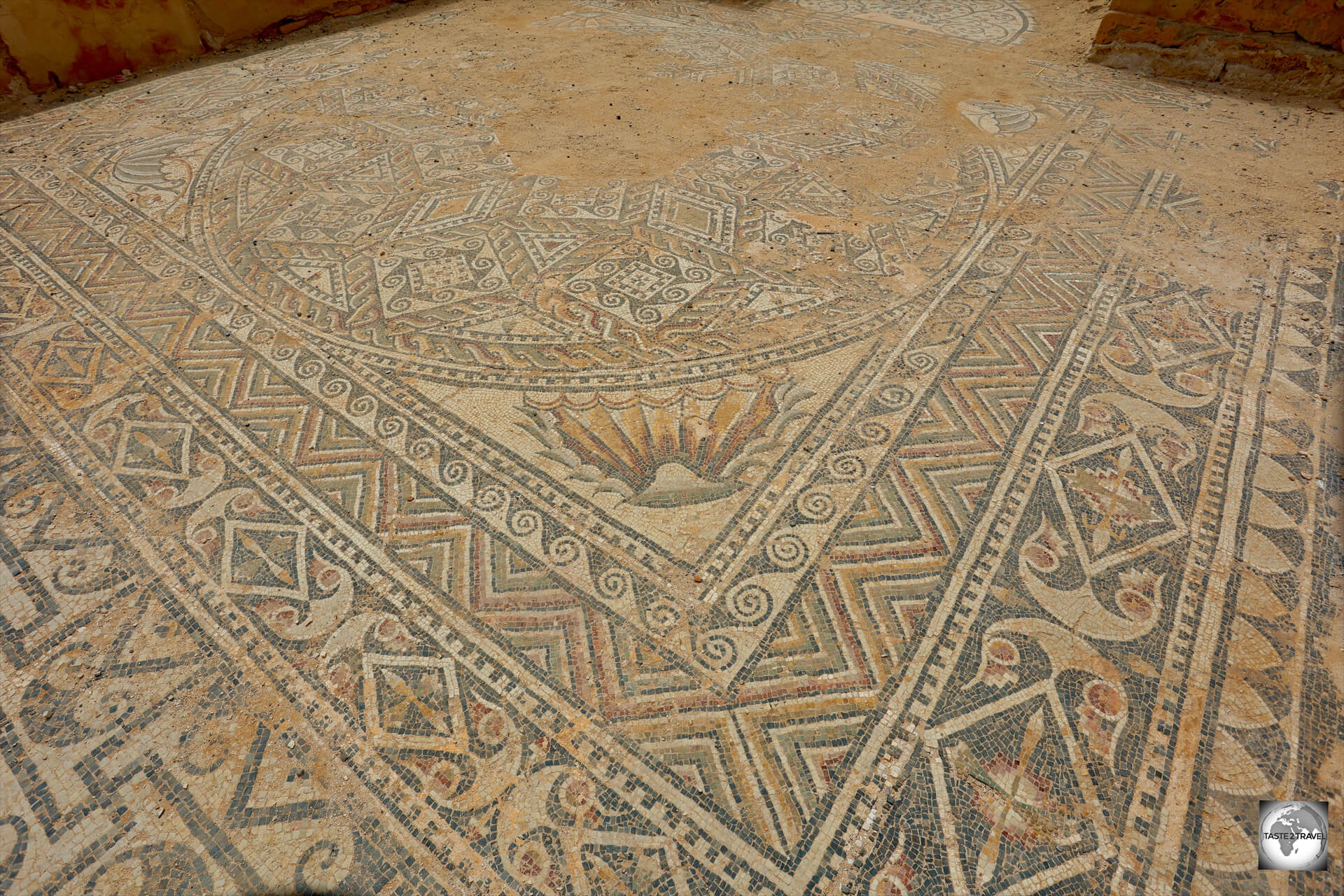
Sabratha was home to many opulent roman residences whose floors were covered with colourful mosaics.
The city was badly damaged by earthquakes during the 4th century which led to its decline. It fell under control of the Vandal kingdom in the 5th century, with large parts of the city being abandoned.
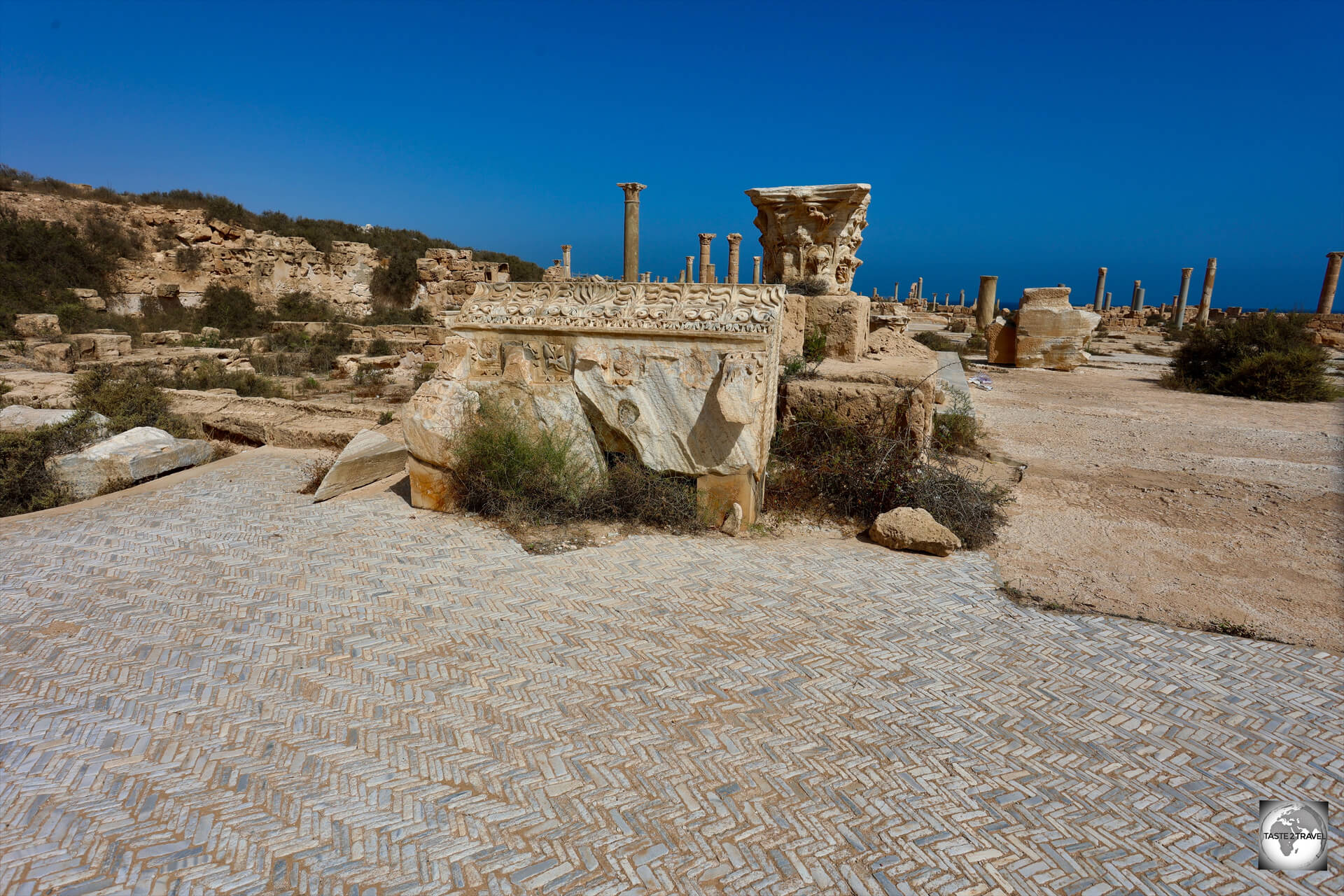
Houndstooth mosaic was popular in Roman times,
Highlights of the site include the Roman theatre which retains its three-storey architectural backdrop.

A mosaic at the entrance to a bathhouse displays sandals, olive oil (used for massage) and a pair of strigils, which were used for scrapping off dirt, perspiration, and oil.
Many colourful mosaics have also been uncovered, including one mosaic at the entrance to a bathhouse which features a pair of sandals, a vessel of olive oil (used for massage in Roman baths) and a pair of strigils (a curved metal scrapper which is used to cleanse the body by scraping off dirt).

One of many fine mosaics at Sabratha.
Unfortunately, coastal erosion over the centuries has led to some of the former residences falling into the sea.

Coastal erosion has resulted in some of the former residences, and mosaics, being lost to the sea.
Site Expert/ Guide
I did a walking tour of Sabratha, again in searing 40-degree Celsius heat, with a local guide, Tareq.
Besides being an expert on Sabratha, Tareq also knew all the good photography positions around the site which was very much appreciated by this photographer.
Roman Theatre

A highlight of Sabratha, the Roman theatre is considered to be the most complete in the world.
A highlight of Sabratha is the spectacular roman theatre which lies on the city’s outskirts, beyond its Byzantine walls.

A view of the spectacular Roman theatre at Sabratha.
Originally built in the 2nd century CE, the theatre appears so complete because of its reconstruction by Italian archaeologists in the 1930s.
After its reconstruction, the theatre was re-inaugurated by Mussolini and once again used to hold plays.

A view of the Roman theatre at Sabratha.
The seating and stage of the theatre are relatively intact, as are the backstage rooms, making it the most complete Roman theatre in the world.

An ancient Roman road leads directly to the Roman theatre at Sabratha, Libya.
Sabratha’s theatre had 25 entrances and could seat approximately 5000 spectators. Its 3-storey stage backdrop is 25 metres high, consisting of 108 Corinthian columns arranged in three stories.

A view of the outside of the Roman theatre at Sabratha.
A truly impressive site!
An interesting trivial fact regarding the Roman Theatre at Sabratha:
In the 2021 documentary The Beatles: Get Back, directed by Peter Jackson, it was mentioned that the Sabratha Theatre was considered as a possible location where the Beatles could hold their final live concert as a group.
They instead performed their last concert on the rooftop of their Apple Corps headquarters.
Brothel Street

A penis marker indicates Brothel Street.
They say it’s the oldest profession in the world!
Prostitution was not only alive and well in ancient Sabratha, but there was a street dedicated to brothels, with a penis sign installed at the corner of the street as some sort of phallic road sign.

If only these buildings could talk! A view of Brothel Street at Sabratha, with the penis indicator on the left.
Gasr Al-Hajj

A panoramic view of Gasr Al-Hājj, a large, circular-shaped, fortified granary, located in the desert of western Libya.
Gasr Al-Hājj is a large, circular-shaped, fortified granary built in the 13th century CE by Abdallah Abu Jatla. It is located in the Libyan desert, about 130 km west of Tripoli, towards the Tunisian border.

An exterior view of the Gasr Al-Hājj fortified granary.
Gasr Al-Hājj was built to serve as a secure granary for families from the surrounding area, in return for a quarter of their crops, which, it is said, the owner had endowed as a waqf for teaching Qur’an and Islamic related subjects to the people of the area.

A view of Gasr Al-Hājj.
The building originally comprised 114 chambers, each allocated to a single family.
It is also speculated that the number 114 was used symbolically to reflect the number of Sura in the Qur’an.
The number of chambers as of now, is 119, as a result of splitting 10 chambers due to inheritance disputes.

A view of one of the 114 chambers which were once used to store food.
Other changes to the original design include the addition of 29 cellars.
Gasr Al-Hajj Tank Monument

The three tanks which comprise the tank monument, near the village of Gasr Al-Hajj, are a truly striking, and somewhat quirky, sight.
Located on the highway, 130 km west of Tripoli, at the turnoff to the village of Gasr Al-Hājj, lies a truly bizarre sight – a tank monument, which could also be considered ‘tank art‘.
The three tanks, two of which are planted upright in the ground, were captured, by rebels, from Muammar Gaddafi’s forces during the Libyan Civil War.
Kabaw

A panoramic view of the fortified granary at Kabaw.
Located in the Nafusa Mountains, west of Tripoli, the Berber village of Kabaw is home to another fortified granary, which is constructed from a combination of rock, gypsum and mud-bricks.

The entrance to the fortified granary in the town of Kabaw.
This impregnable, hilltop fort, which is more than 700 years old, served as both a strategic stronghold and as a granary.
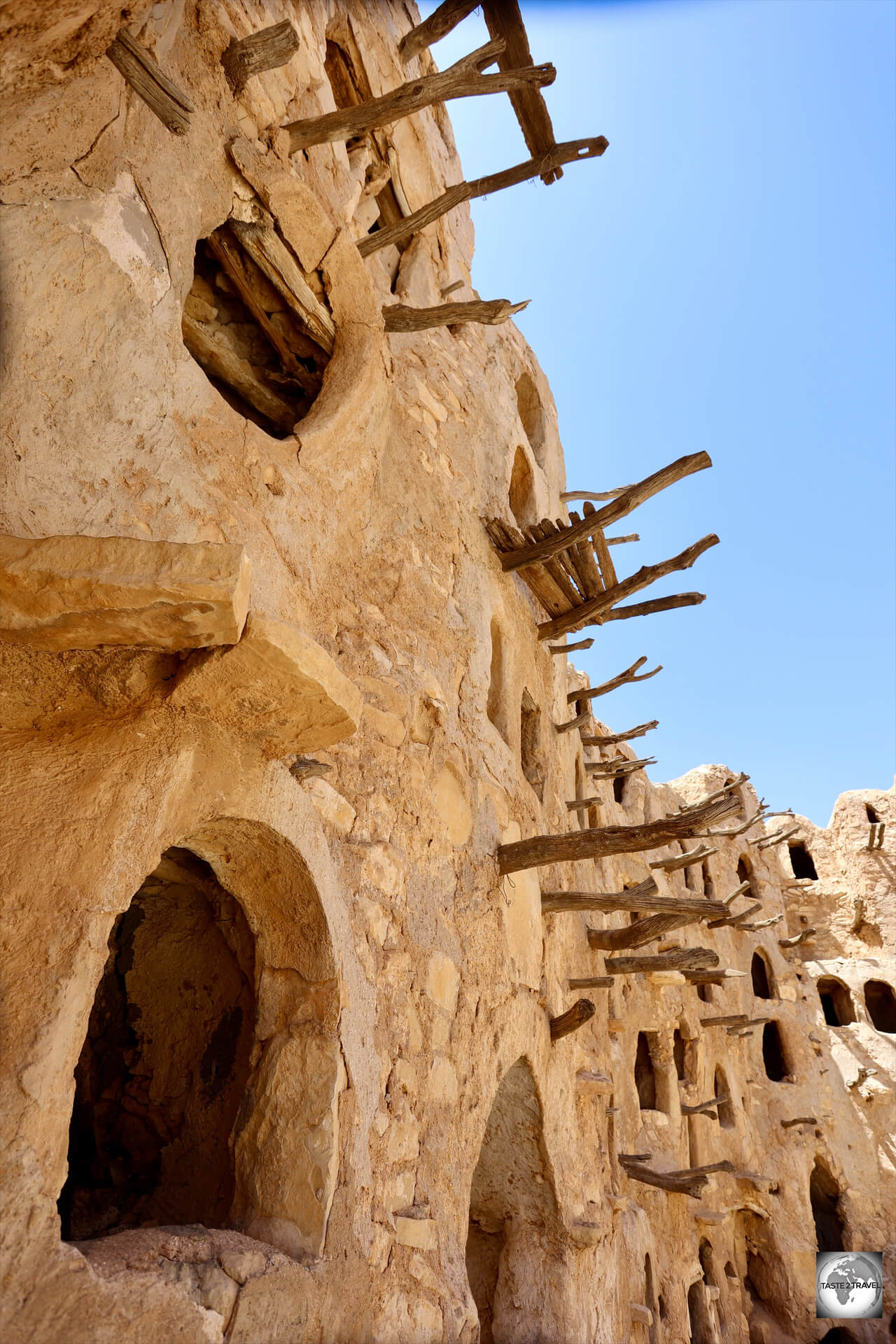
Tree branches, embedded into the mud wall of the granary, were used as a ladder to access higher chambers.
The circular-shaped fort consists of 360 rooms which are built on six floors.

Wooden tree branches and stone steps were used to climb the Kabaw granary.
Stone steps and wooden planks provide access to the upper rooms.
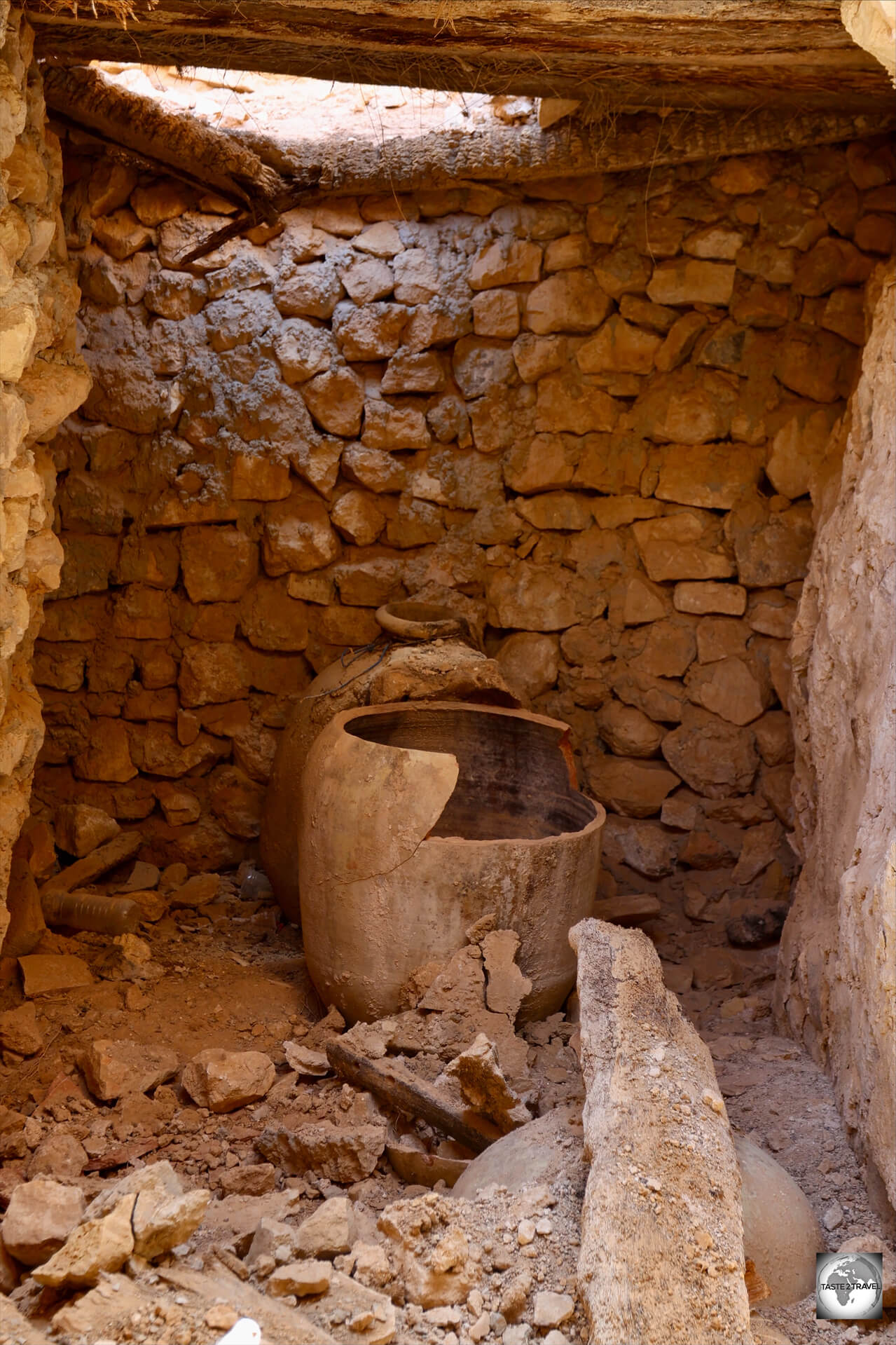
Ancient terracotta pots, which one held olive oil, remain inside once of the chambers at Kabaw.
Food, such as dates, olive oil, figs, wheat, and barley were stored here for use between harvests.
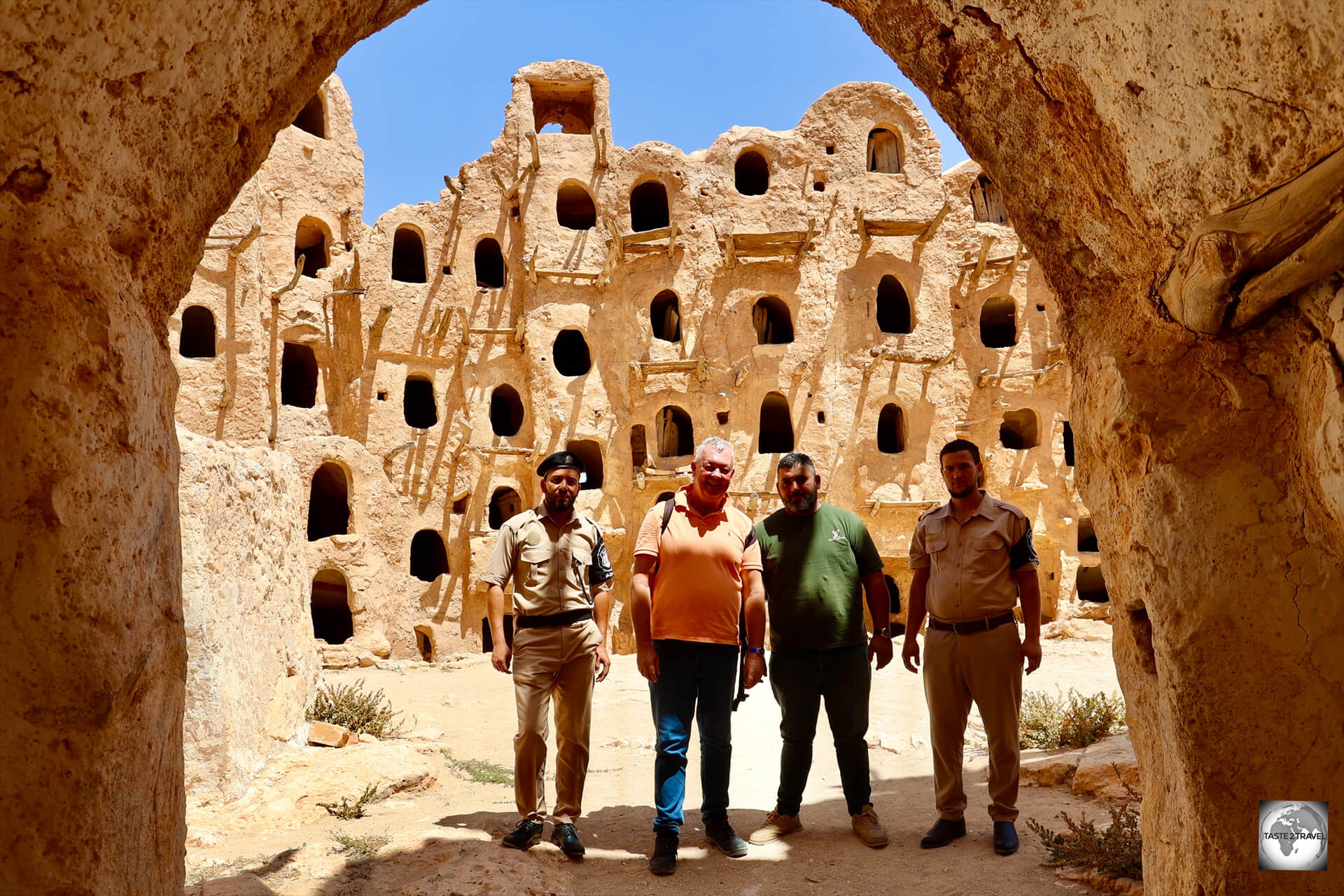
A photo of myself, my police escort, and the two tourist police who are responsible for the Kabaw fortified granary.
Due to the complete lack of tourists in Libya, most sights are unattended.
Each time, as we approached a sight, my guide, Masoud, would call ahead to ask the responsible attendant to meet us at the sight. In the case of the Kabaw fort, we were greeted by two uniformed tourist policemen who are responsible for the sight.
They open the sight for us, then closed it again once we were finished with pour visit.
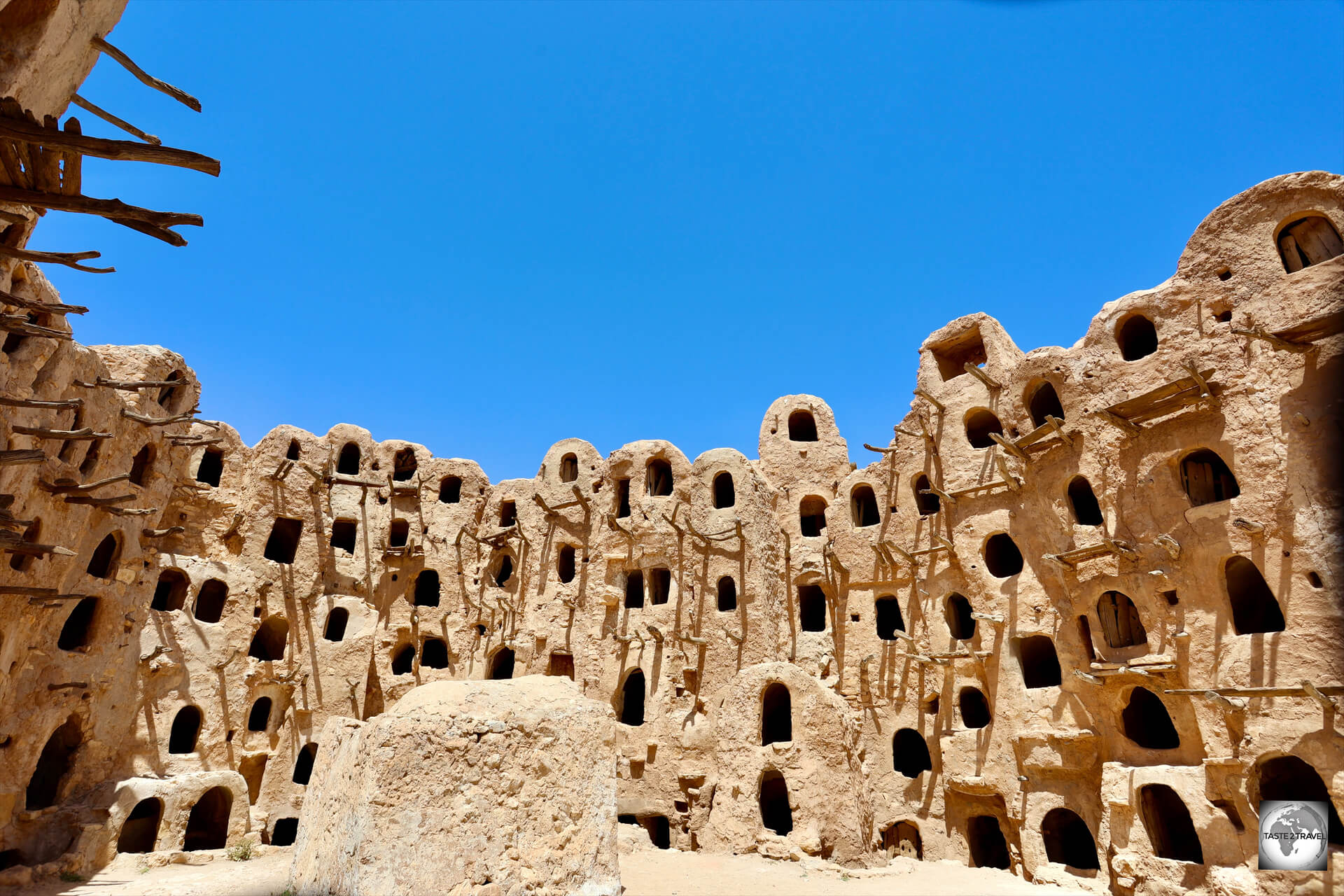
Due to the complete lack of tourists in Libya, I had every site to myself.
They then provided an escort through town, which was not out of any security concern, but rather as a courtesy. They escorted us to the edge of town, and then bid us farewell!
The Libyans are incredibly kind and welcoming.
Tormisa

The stunningly beautiful, abandoned ancient village of Tormisa, is perched on the edge of an escarpment in the Narfusa mountains.
The abandoned mud-brick village of Tormisa is located on the edge of a dramatic escarpment in the Nafusa Mountains, west of Tripoli.

Standing on the edge at Tormisa village.
Offering panoramic views of the surrounding desert plain, this former Berber village is more than 2,000 years old.

Stunning views in all directions from the village of Tormisa.
Decorative markings on the houses indicate that the dwellings were once occupied by Christians, Jews and Muslims.

Decorative markings, which represent many different faiths, can be found on the houses at Tormisa.
Some of the interiors of the houses have been left just as they once were.

The remnants of an ancient olive oil press remain inside one of the buildings at Tormisa.
In one building, the remnants of an ancient olive oil press, including giant mill stones which were used to crush the olives.

A view from the abandoned village of Tormisa.
Gharyan
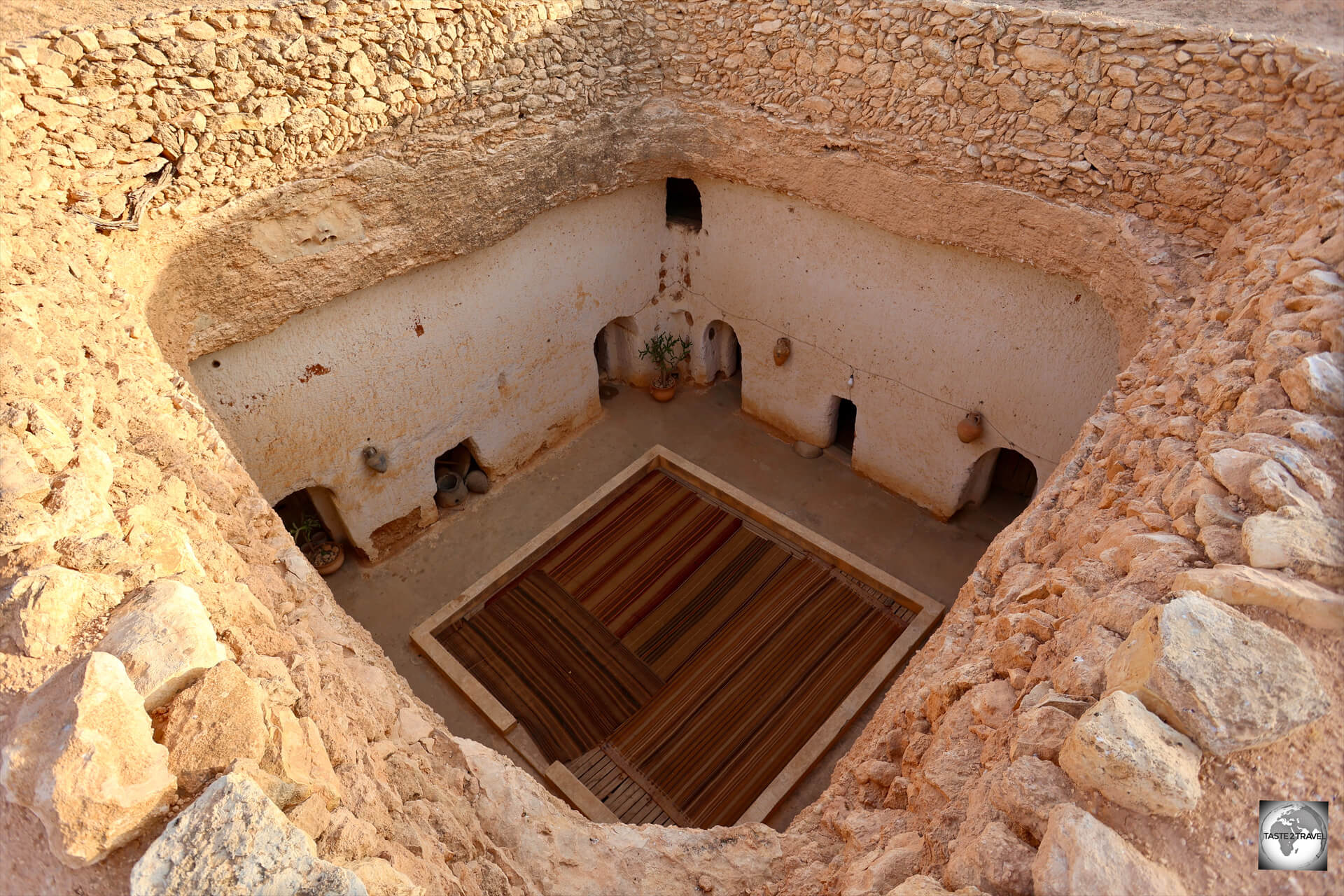
The town of Gharyan is known for its subterranean, troglodyte houses.
Located in the Nafusa Mountains, 100 km south of Tripoli, the city of Gharyan is famous for its Troglodyte (which means ‘cave dweller’) underground houses.
The troglodyte houses of Gharyan are reported to have first been made during the 16th century CE by Jewish refugees.

A view of the courtyard of the troglodyte house which is owned by Mr. Al-Arabi Belhaj.
While most troglodyte houses in Gharyan are no longer in use, one enterprising local, Mr. Al-Arabi Belhaj has turned his former family cave home into a show home for visiting tourists.
In 1510, Tripoli was captured by the Spanish, which caused the Jews living there to flee from the city. Some migrated southwards, seeking shelter in various mountain towns such as Gharyan.

Mr. Al-Arabi Belhaj (right), with my guide, Masoud, escaping from the searing heat outside, in one of the cool underground rooms.
In Gharyan, the new Jewish residents began to build their dwellings by digging into the mountain’s soft limestone.
The troglodyte cave houses of Gharyan come in different forms.

A view of one of the many rooms at the Troglodyte house.
Some, for example, are simple cave-like homes made by digging horizontally into the slopes of hills.
Others are more elaborate, with a network of rooms clustered around a central pit serving as a source of light.
These dwellings are produced by digging vertically into the ground, and then forming the adjacent rooms by digging horizontally underground.

The different floor levels in each room were for different members of the household.
In each of the rooms, different floor levels indicated sections for different members of the household. A dividing curtain separated each section, with the parents occupying the rear section, children in the middle section and guests greeted at the front of the room.
One of the advantages of such houses over conventional ones situated above ground is that they are kept insulated during the winter, and remain cool during the summer.
Accommodation

A view of the Four Points by Sheraton Hotel in Tripoli.
There are many hotels in Tripoli which cater to all budgets.
Hotel bookings are organised by the tour company, based on the requirements of their clients.

My room at the Four Points by Sheraton Hotel in Tripoli, which, despite a heatwave, had no A/C.
During my time in Libya, I stayed at the 4-star Four Points by Sheraton Hotel which seems to be the hotel of choice for most visitors.
Despite currently being rated as the top hotel in the country, the hotel received no power from the power grid during my entire stay.
The hotel instead was powered by one, inadequate, generator. This meant that the air-conditioning, which consumes so much power, had to remain off – a big problem considering the country was in the grip of a heatwave with daily temperatures in the mid-40 degrees Celsius.

A sunset view over the Mediterranean Sea, from the Sheraton Hotel in Tripoli.
As can be expected from a Sheraton, the hotel includes a swimming pool, gym, café and one restaurant. The hotel restaurant provides a decent buffet breakfast and buffet dinner but no a la carte menu.

A view of the atrium of the Sheraton Hotel in Tripoli.
Sheraton Hotels and Resorts had big plans for their extensive waterfront site at Tripoli and, prior to the civil war, were busy building a mega-hotel complex.
Sitting alongside the existing Four Points by Sheraton Hotel tower, the much larger Sheraton Tripoli Hotel is a partially-completed luxury hotel which has laid abandoned for the past 13 years.

A view of the abandoned Sheraton Tripoli Hotel construction site.
A structure with many hundreds of rooms, the hotel was incomplete when the Libyan Civil War broke out in February 2011. At the time, construction was halted and the structure has remained in a state of limbo ever since.

A view of the abandoned Sheraton marina and luxury villas complex.
Likewise, on the other side of the Four Points by Sheraton tower, a marina complex, which is surrounded by luxury villas, also remains unfinished and abandoned.
Abandoned Construction Sights
The streets of Tripoli are lined with many such abandoned construction sites, including one waterfront, three-tower, high rise complex.
Most projects were being built by foreign companies, who withdrew from Libya at the commencement of the civil war in 2011. These companies have yet to return, due to ongoing security concerns.
Eating Out
Libyan cuisine reflects the country’s diverse cultural influences. Staple foods include couscous, rice, and bread, often accompanied by various meats (such as lamb and chicken), vegetables, and aromatic spices. Local specialties and street food are an essential part of experiencing Libyan culture.
Restaurants / Cafés

As a fussy caffeine addict, I can report that every coffee I was served in Libya was excellent.
Due to its close proximity to Bella Italia, and following its time as an Italian colony from 1912 until 1947, Libya has inherited an excellent coffee culture.
From the finest cafés in Tripoli, to small town establishments, cappuccinos are always served with a firm, silky crema that would meet the approval of any Italian barista.
Libyans tend to drink espresso but are also partial to cappuccino.
Bars
Forget it!
Alcohol is forbidden in Libya!
Visa Requirements

My Libyan visa, with entry stamp, which was issued on arrival at Mitiga International Airport.
The Visa Policy of Libya is very straight forward – almost all nationalities require a visa!
Only nationals of Tunisia and Jordan can enter Libya visa-free.
Nationals of six countries (Bangladesh, Iran, Pakistan, Sudan, Syria and Yemen) are banned from entering Libya, while nationals of Israel, and anyone bearing proof of having visited Israel, are also banned from entering Libya.
Tourist Visas
Tourist visas must be organised through a Libyan-registered tour company.
Recently introduced, visa-on-arrival (VOA), is available at Tripoli Airport (currently Mitiga International Airport) and at the Tunisian land border.

A copy of my Libyan Visa Authorisation letter.
VOA’s can only be issued to those visitors who are in possession of a Visa Authorisation letter.
The letter is issued by Libyan Immigration services, following an application from a Libyan-registered tour company.
It took one month for my via authorisation letter to be issued!
Another requirement is that a representative from the tour company meets each visitor at the immigration desk at the airport (or land border) and that the tour company facilitates the issue of the visa.
There is nothing for a visitor to do, other than to wait for the visa to be issued, which took one hour in my case!
I visited Libya with Tidwa Tours, who I would highly recommend. They took care of the entire visa process!
Getting There

A Ghadames Air Transport plane, on the tarmac at Mitiga International Airport in Tripoli.
Air
Tripoli International Airport (currently closed)
As critical infrastructure, airports in Libya were heavily bombed during the Libyan Civil War. In 2014, the main international gateway, Tripoli International Airport (IATA: TIA), was heavily damaged in the Battle of Tripoli Airport.
TIA reopened for limited commercial use in July 2017 but was again closed in 2019 following further damage sustained during the Western Libya campaign. TIA is now currently being completely rebuilt by an Italian consortium.
Mitiga International Airport
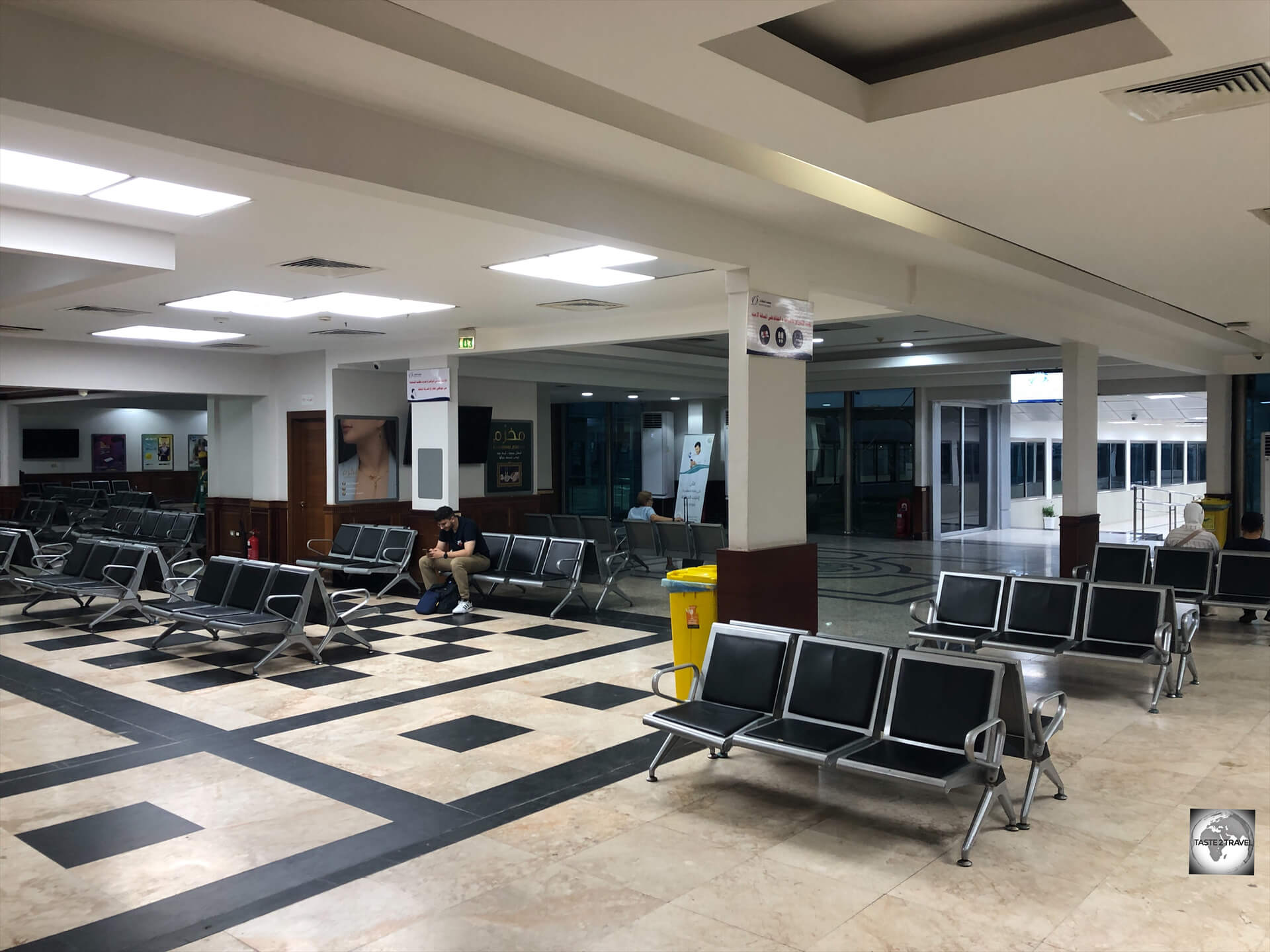
The departure hall at Mitiga International Airport.
In the meantime, all international flights to Tripoli arrive at the much smaller Mitiga International Airport (IATA: MJI) which normally only serves domestic flights.
Mitiga airport has a colourful history, being first established in 1923 by the Italians as an Air Force base. During WWII, the Germans used the base for their operations in North Africa.

My boarding pass for my Libyan Wings flight from Istanbul (IST) to Mitiga International Airport.
During WWII, the British captured the base, which they then transferred to the United States military. In 1969, the US military abandoned the base following a coup d’état in Libya. The Americans then bombed the base in 1986 during Operation El Dorado Canyon.
In 1995, the air base was converted to a second civilian airport for Tripoli, and was given its current name.
During the 2019–20 Western Libya campaign, the airport was frequently targeted with airstrikes from the opposing Libyan National Army. Following repairs, the airport was finally reopened in May 2021.
While connections to Tripoli are limited, more connections are slowly coming online. During my visit, ITA Airlines (the reborn Alitalia) started flights between Rome and Tripoli.
Also, during my visit, Fly Oya commenced flights to Dubai International Airport (IATA: DXB).
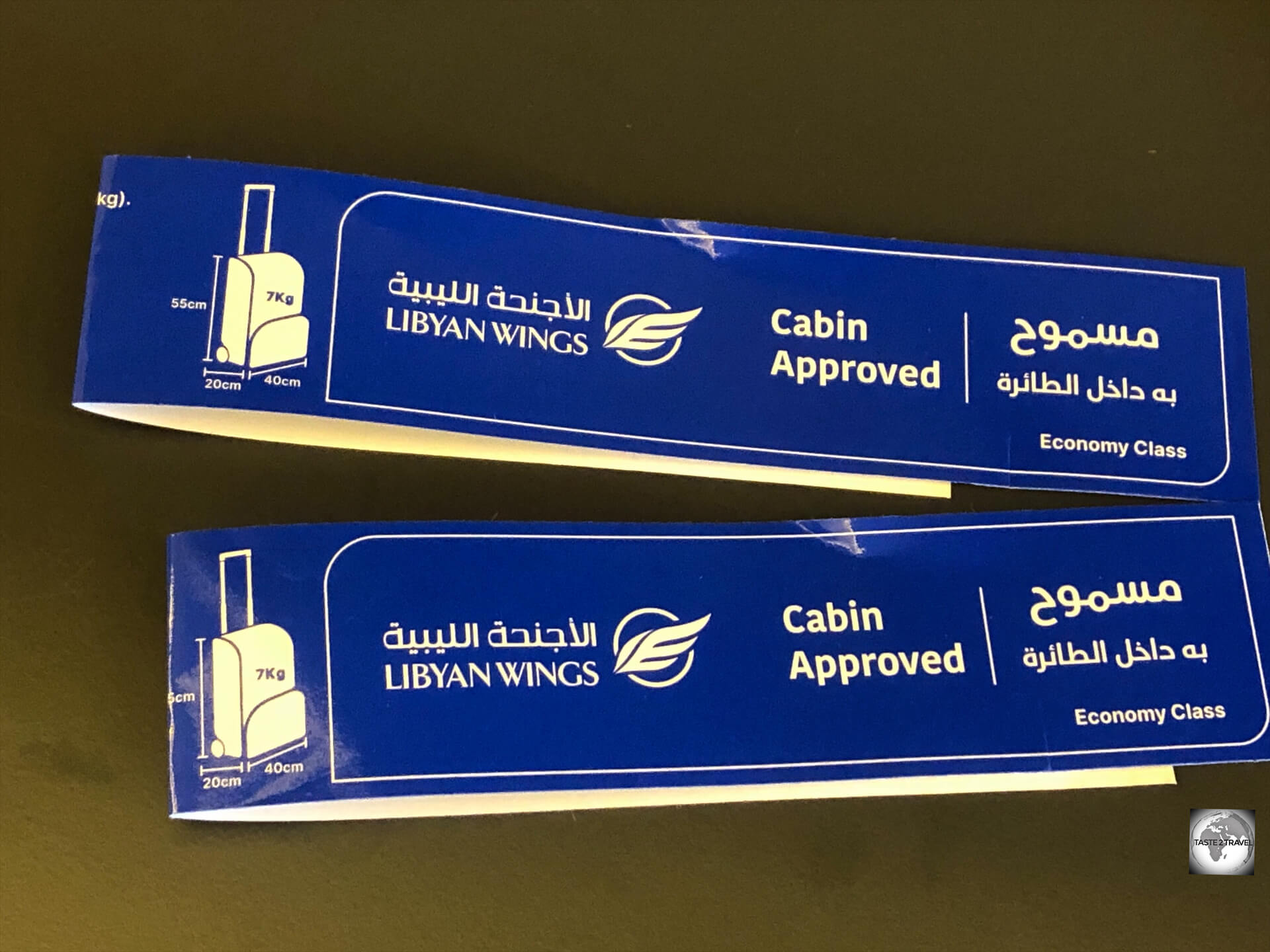
I flew between Istanbul and Tripoli with Libyan Wings, who were excellent!
The Libyan airline which has the best reputation for reliability and punctuality is Libyan Wings, which connects Tripoli to Istanbul International Airport (IATA: IST) and Tunis International Airport.
I flew with Libyan Wings from IST and would recommend them!
The following airlines operate scheduled services to/from Mitiga International Airport:
- Afriqiyah Airways – flies to/ from Alexandria, Benghazi, Cairo, Istanbul, Khartoum, Niamey, Sfax, Tunis
- Air Libya – flies to/ from Benghazi
- Berniq Airways – flies to/ from Benghazi, Istanbul
- Buraq Air – flies to/ from Alexandria, Benghazi, Istanbul, Tobruk
- Egyptair – flies to/ from Cairo
- Fly Oya – flies to/ from Dubai, Istanbul
- Ghadames Air Transport – flies to/ from Istanbul, Tunis
- Global Aviation and Services Group – flies to/ from Benghazi
- ITA Airways – flies to/ from Rome
- Libyan Airlines – flies to/ from Alexandria, Amman–Queen Alia, Benghazi, Cairo, Istanbul, Jeddah, Niamey, Tunis
- Libyan Wings – flies to/ from Istanbul, Tunis
- Tunisair – flies to/ from Tunis
- Tunisair Express – flies to/ from Djerba, Sfax
Airport Transport
All visitors will be met at immigration by their respective tour company and transferred to their accommodation.
There are many taxis at the airport, should one be needed.
Flight Costs

My Libyan Wings boarding pass, flying from Tripoli to Istanbul.
I flew to Libya from Istanbul with Libyan Wings.
It should be noted that you are unable to purchase a ticket online from the Libyan Wings website. You can book flights using an OTA such as Expedia or Skyscanner but they charge much more than the airline. I was quoted US$1,200 for a return airfare from Expedia! Ouch!
I contacted Masoud at Tidwa Tours who was able to book me on the same flight for US$520!
I highly recommend using Tidwa Tours for your tour of Libya, and I especially recommend asking Masoud to book the flight for you.
Land
Currently, the coastal land border between Tunisia and Libya at Ras Ajdir is open.
Visitors wishing to enter Libya overland from Tunisia can make arrangements through a Libyan tour company, such as Tidwa Tours, who will organise a visa and meet their clients at the border crossing.
Getting Around
While taxis and mini buses operate in Libya, all visitors are fully escorted by their tour company.
That’s the end of my Libya Travel Guide if you wish to leave feedback, you can do so using the form below.
Safe Travels!
Darren
Author: Darren McLean
Darren McLean is an Australian, full-time, digital nomad who has spent 37 years on a slow meander around the globe, visiting all seven continents, 189/ 193 UN countries and 240/ 251 UN+ countries and territories.
He founded taste2travel to pique one’s curiosity and inspire wanderlust.

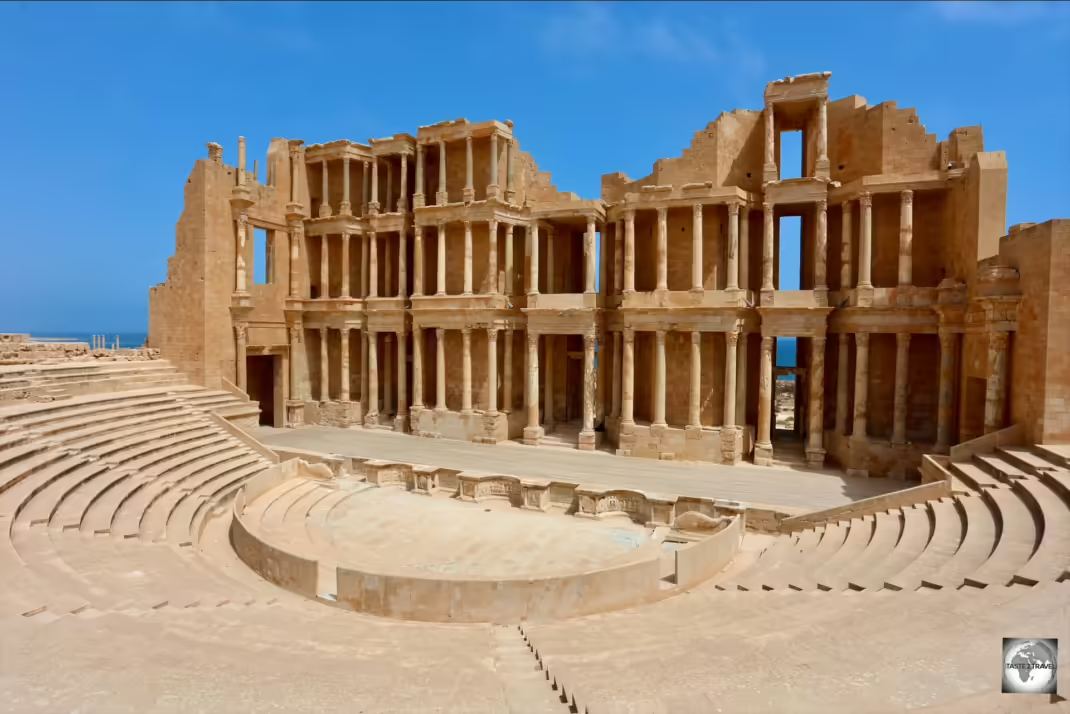




Once again in this guide, a wealth of historical, geographical and practical informations very interesting!
Decidedly people from countries in trouble are the most hospitable!
This country is an incredible archaeological wealth!
I understood that the visit of this country is very framed; Darren, do you think it is possible to visit the desert peoples you speak your guide